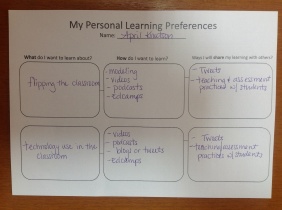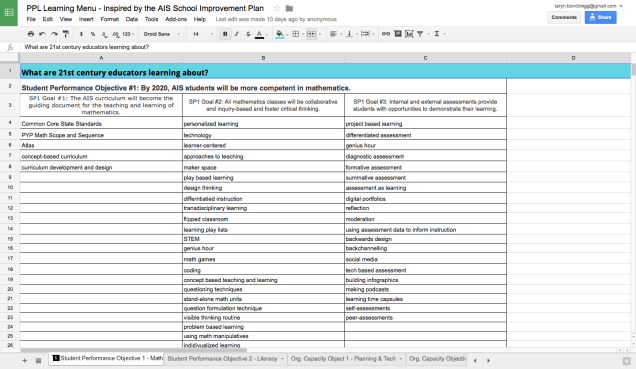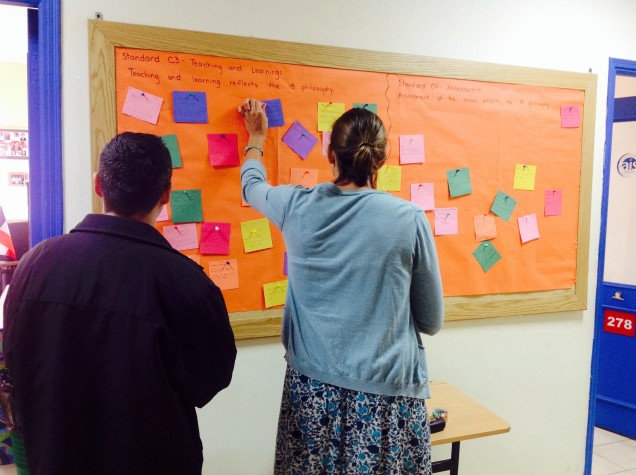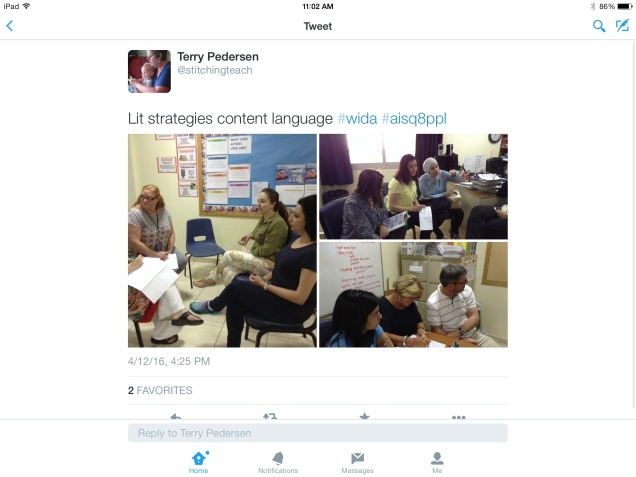A few weeks ago I shared my thinking about how best to structure professional development focused around student agency, and this past weekend I had a chance to test it out! I spent the day with an amazing group of passionate and dedicated educators all committed to upping the amount of voice, choice and ownership in the work they do to support their learners in their specific role.
Here is how it went…
The Before:
The first thing I knew I needed to do was get to know them as learners. So I sent out a quick Google Form that helped me begin to understand who they are and what they are hoping for from our time together.
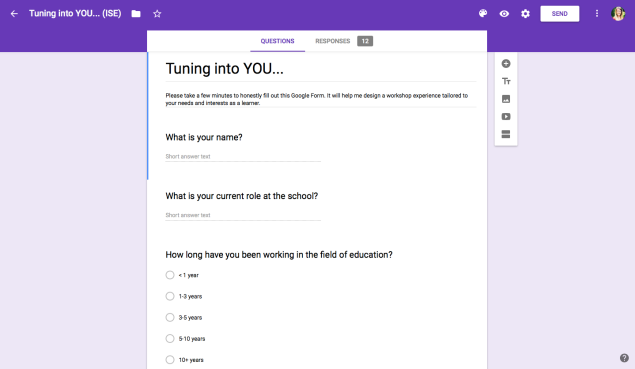


The results were very informative and helped me put together a day of professional learning about agency tailored to their needs.



From there I focused on building a workshop where they were able to not only learn about learner agency, but learn through experiencing their own agency as learners. All of my planning and decisions were guided by the question, “How can I help them learn about student agency” instead of focusing on “How can I teach them about student agency”.
Before the day of the workshop I also spent some time putting together a virtual learning space, our own Google Classroom, to help distribute documents and resources.

I knew that not all participants were comfortable on Google Classroom, so I insured that there were plenty of other options and avenues for accessing resources and using some of the templates.
For example, sending out links via email:

And having shorty links visible when they arrived the day of the workshop:

The During:
When participants arrived the day of, I made sure they all had access to the presentation slides – which were editable – as there were a few activities where everyone would need to contribute thoughts and ideas.

First we started with a simple activity to help them connect with each other, the topic of the workshop and their own experience as a student.

Then I was transparent about the structure of the workshop – Choose, Act, Reflect – and my thinking behind it.

The “Choose” Portion of the day…
To help them self-assess where they are in their own journey of understanding and supporting student agency, I used a Gradual Increase of Independence (adapted from the original design by @orenjibuta)


Next I guided them in using the data from their own self-assessment to create their own personalized success criteria for the day





Then, we co-constructed a menu about documenting learning – starting with the “why”, and moving to possible “hows” and “whats”

Everyone took a turn to share how they were planning to document their learning throughout the day, and it was so great to see so many different approaches!
After that, it was time for them to plan their day! I took some time to give them an overview of all the different possible options that could support their learning throughout the day.

I briefly explained what my optional workshops were about and how the conferences would work:


Who the Skype experts were:


I helped them centralize the things they might want to discuss with one another:

I previewed the resource document that I built for them.




And then… they were off planning!!! (using their success criteria and self-assessment to inform the choices they made about their learning)

The “Act” Portion of the day…
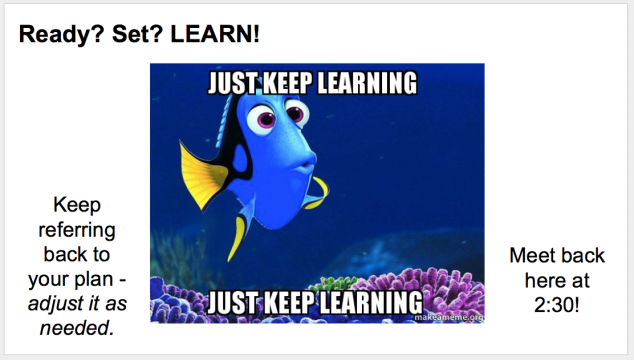
Optional Workshops:
1. The “Why” Behind Student Agency
First we started with an opportunity for them to tune into their own understanding of what they think student agency is.

Next we moved into a “Tug of War” to help them debate and discuss a variety of underlying beliefs, assumptions and philosophies connected to agency.

Finally, we did Chalk Talk to help them engage with some provocative stimuli to poke and provoke their thinking and emotions further. (Warning – some stimuli are quite extreme!)


2. Transferring Decision into the Hands of Learners
First, I had everyone brainstorm all the decisions they make in their role as an educator

Then, I had them use a quote from the Empower book to challenge them to think about which of those decisions learners “should” or “could” be making themselves.



Then I invited them to visit other groups and leave some feedback to push each other’s thinking a little further.


Finally, I had them reflect on any shifts in their thinking as a result of the activity.




3. Self-Reflection and Planning for Action
First I introduced a few self-reflection tools, to help them see where they are already respecting and supporting student agency and also where there might be some space to make some changes in their practice to work towards even more respect and support for student agency.
I used a sketchnote from @terSonya

and a questionnaire that I developed





Once they had some time to engage with the tools, I supported them in using their self-reflection to develop a personal action plan



Optional Guided Groups or Conferences:
I only had one conference slot filled about agency vs. the curriculum. We sat and chatted for 15 minutes about questions, challenges, ideas and resources.
Skypes with experts:
I was so fortunate to have 4 amazing educators donate some of their weekend to support the learning of people in the workshop.
@bondclegg chatted with MYP and DP educators about how to up the agency within and around program restrictions
@hktans chatted with leaders and administrators about how to support the development of teachers when it comes to understanding agency and also how to bend and break rules in order to re-imagine what school could be
@ms_AmandaRomano shared her own personal journey as an experienced educator unlearning, learning and relearning how to support student agency as a classroom teacher
Stephen Flett chatted with educators about how learning support can function within a system that supports more student agency

Collaborative Conversations:
There was LOTS of connecting, chatting, dialoguing, brainstorming and challenging

Independant Inquiry:
There was also lots of personal inquiry into the resource document

The “Reflect” Portion of the day…
When we all came back together at the end of the day, I guided them through a formative self-assessment where they were able to choose how best to assess their personalized success criteria to know where they currently are and where they need to go next

Then we spent some time collectively brainstorming the “why”, “how” and “what” of reflection
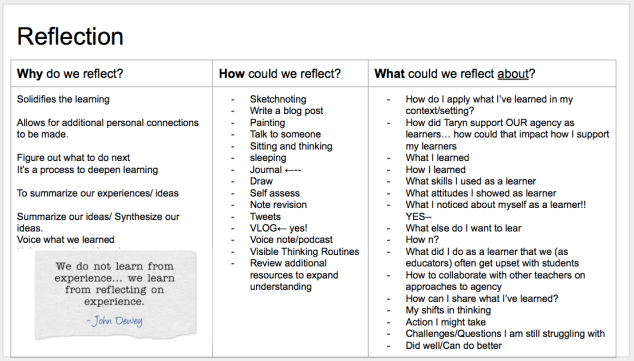
and everyone chose the style and content of reflection that was most useful and comfortable for them. It was great to see such a wide range of approaches to reflection! Everything from painting, writing, sketching, talking, sleeping… to even graphing!


Then we spent a few minutes talking about how the learning doesn’t have to end…

How fears are normal…

And how leaving your comfort zone often leads to something amazing!
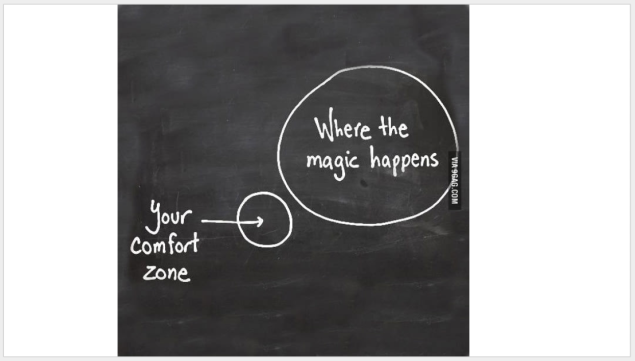
Finally, before they left, I asked if they could share their honest feedback with me about the day. I wanted to make sure I was honouring their voice as learners!

The After:
When I got home, I read through the feedback:




Reading through their feedback was so helpful. It helped me reflect on what parts of the workshop worked really well, and also some parts of the workshop I need to revise for next time.
As I was reading through the “wishes” I noticed that there were many people who felt that two things were missing from the workshop:
- More information about the approach myself and my team take (Studio 5)
- Tangible strategies for supporting student agency (voice, choice and ownership)
At first I started to go down the path of regret and all the shulda, coulda, wouldas…. but then I realized that just because the workshop was over, didn’t mean that my support for their learning had to end! So I decided to take action and respond to what their feedback was telling me.
I made two Google Slide presentations (linked above) – one to address each area that seemed to be missing from the workshop. And I sent those presentations to the workshop participants via our Google Classroom and email.


Now I can feel a little bit better that I honoured their voice as learners, and took action to respond to their needs… even if it was technically “after the workshop”.
My reflections….
- overall, it was a really great day
- learning through agency is essential in order to understand agency
- empowering educators to understand themselves as learners and where they are on their own journey helps the learning extend beyond the hours of a workshop
- investing time in the “before” and “after” really helped me honour their voice as learners
- this structure created a really relaxed, comfortable vibe for the day
- the medium IS the message
How do you support educators in developing their understanding of student agency?
What feedback do you have for me as a workshop planner/facilitator in order to better meet the needs of my learners?
APPENDIX (added to the original post)
The Monday after this workshop I received the following email from one of the participants:


What a great feeling to see that learning from the workshop lead to action that resulted in happy, successful teachers and students!!!

















